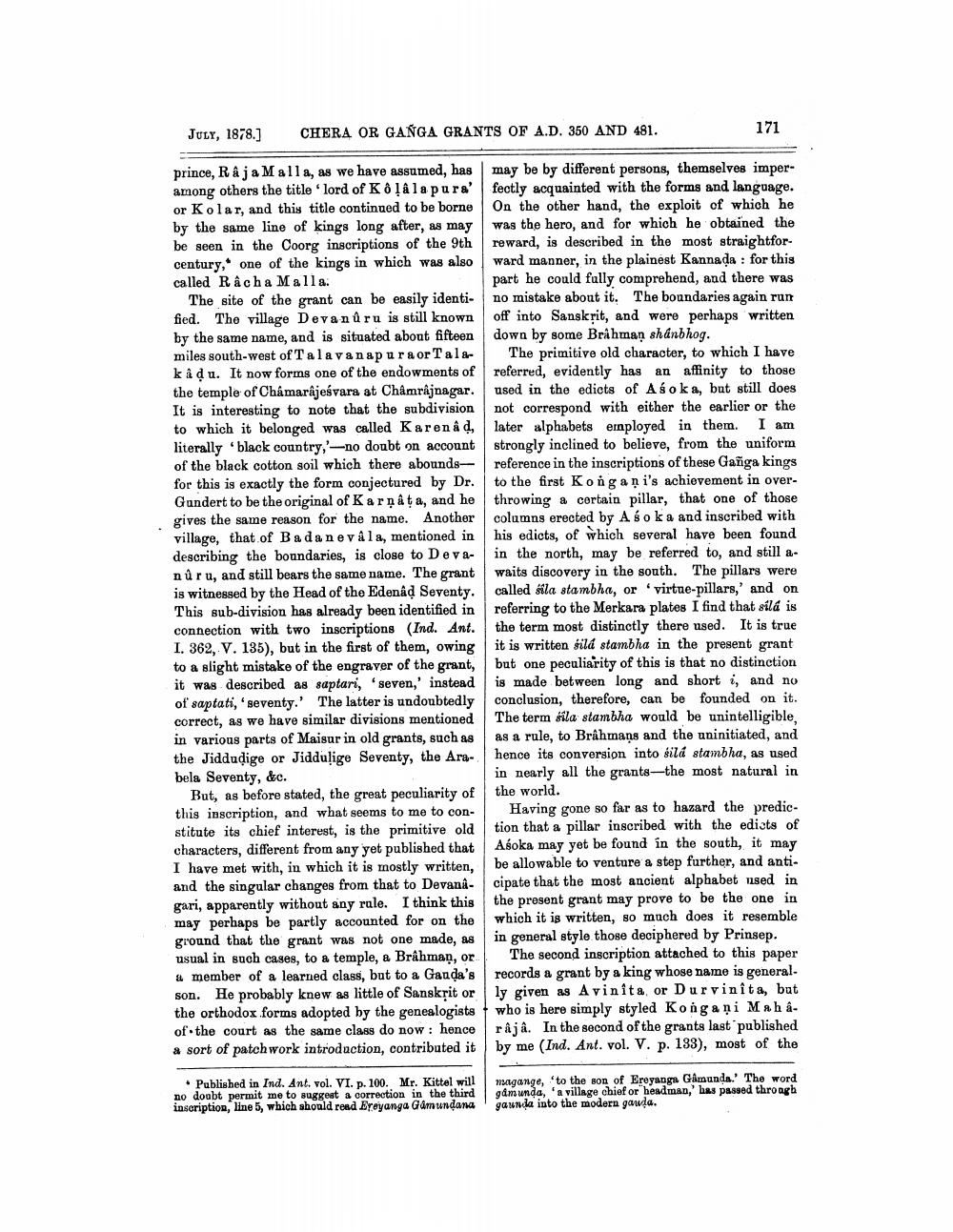________________
JULY, 1878.]
CHERA OR GANGA GRANTS OF A.D. 350 AND 481.
171
prince, Raja Malla, as we have assumed, has among others the title lord of Kôļalapura' or Kolar, and this title continued to be borne by the same line of kings long after, as may be seen in the Coorg inscriptions of the 9th century, one of the kings in which was also called Racha Malla.
The site of the grant can be easily identi- fied. The village Deva nuru is still known by the same name, and is situated about fifteen miles south-west of Talavanapu raor Talkad u. It now forms one of the endowments of the temple of Chámarâjeśvara at Chamrajnagar. It is interesting to note that the subdivision to which it belonged was called Karenad, literally black country,' -no doubt on account of the black cotton soil which there aboundsfor this is exactly the form conjectured by Dr. Gandert to be the original of Karnata, and he gives the same reason for the name. Another village, that of B a da nevåla, mentioned in describing the boundaries, is close to Devanûr u, and still bears the same name. The grant is witnessed by the Head of the Edenad Seventy. This sub-division has already been identified in connection with two inscriptions (Ind. Ant. I. 362, V. 135), but in the first of them, owing to a slight mistake of the engraver of the grant, it was described as saptari, seven,' instead of saptati, seventy.' The latter is undoubtedly correct, as we have similar divisions mentioned in various parts of Maisur in old grants, such as the Jiddudige or Jidduļige Seventy, the Ara- bela Seventy, &c.
But, as before stated, the great peculiarity of this inscription, and what seems to me to con- stitute its chief interest, is the primitive old characters, different from any yet published that I have met with, in which it is mostly written, and the singular changes from that to Devanagari, apparently without any rule. I think this may perhaps be partly accounted for on the ground that the grant was not one made, as usual in such cases, to a temple, a Brâhmaṇ, or u member of a learned class, but to a Ganda's son. He probably knew as little of Sanskrit or the orthodox .forms adopted by the genealogists of the court as the same class do now: hence a sort of patchwork introduction, contributed it
may be by different persons, themselves imperfectly acquainted with the forms and language. On the other hand, the exploit of which he was the hero, and for which he obtained the reward, is described in the most straightforward manner, in the plainest Kannada : for this part he could fally comprehend, and there was no mistake about it. The boundaries again run off into Sanskřit, and were perhaps written down by some Brahman shanbhog.
The primitive old character, to which I have referred, evidently has an affinity to those used in the edicts of Asoka, but still does not correspond with either the earlier or the later alphabets employed in them. I am strongly inclined to believe, from the uniform reference in the inscriptions of these Ganga kings to the first Kong ani's achievement in overthrowing a cortain pillar, that one of those columns erected by A so ka and inscribed with his edicts, of which several have been found in the north, may be referred to, and still awaits discovery in the south. The pillars were called fila stambha, or 'virtue-pillars,' and on referring to the Merkara plates I find that sild is the term most distinctly there used. It is true it is written sild stambha in the present grant but one peculiarity of this is that no distinction is made between long and short , and no conclusion, therefore, can be founded on it. The term sila stambha would be unintelligible, as a rule, to Brâhmans and the uninitiated, and hence its conversion into silá stambha, as used in nearly all the grants—the most natural in the world.
Having gone so far as to hazard the prediction that a pillar inscribed with the edists of Asoka may yet be found in the south, it may be allowable to venture a step further, and anticipate that the most ancient alphabet nised in the prosent grant may prove to be the one in which it is written, so much does it resemble in general style those deciphered by Prinsep.
The second inscription attached to this paper records a grant by a king whose name is general. ly given as Avinita or Durvinita, but who is here simply styled Konga ni Maharâjâ. In the second of the grants last published by me (Ind. Ant. vol. V. p. 133), most of the
• Published in Ind. Ant. vol. VI. p. 100. Mr. Kittel will no doubt permit me to suggest a correction in the third inscription, line 5, which should read Ereyanga Gamundana
wagange, 'to the son of Ereyanga Gámunda.' The word gamunda, 'a village chief or headman,' has passed throagh yaunda into the modern gawda.




